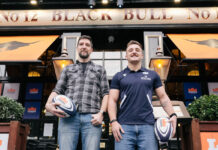Speyside brewer has plans to increase its footprint in pubs and bars

By Dave Hunter
IT was early in 2017 when Speyside craft brewery Keith received an unexpected sales boost.
Snake Venom, the company’s 67% ABV beer that was exclusively available in export markets, was highlighted by lifestyle website the LADBible.
Within hours a small brewery in Moray had become world-famous.
“We were out for dinner and my phone went off,” sales and marketing director Andrew Chapman told SLTN.
“I saw someone had tagged me in something and put it back in my pocket. It buzzed again and again. I expected the worst and opened my phone. I saw it was LADBible but had no idea what was coming. By the time I’d shown my wife it had gone up 50,000 views. In the time it had taken me to pass her the phone. By the time I passed the phone to my sister it had gone up by another 50,000. That was the Friday. By the Monday morning it had been watched by 14 million people.”
The coverage led to thousands of sales enquiries from across the globe and kick-started a year of growth that has barely slowed down since.
Keith had already been through a period of expansion in 2016 that saw its core range of beers increase to nine: Larger Keith (4.5% ABV lager); Pale Keith (5% ABV IPA); Stout Keith (5% ABV stout); Herr Keith (4.5% ABV wheat beer); Sir Keith (10% ABV barley wine ale); Trevor and Frank (4% ABV strawberry and raspberry beers, respectively); Wry Keith (5% ABV rye beer); and Pump’d Keith (6% ABV pumpkin ale).
A six-figure investment in the brewery this year saw the installation of additional brewing equipment, a cool room and extra storage space while, on the staff side, the company recruited additional brewers and office staff.
The investment appears to be paying off, with turnover having increased from around £40,000/£50,000 in 2015, when the current owners took over and rebranded the brewery (it had previously been known as Brewmeister, a brand name the company retains in export markets); to £240,000 in the 2016 financial year and £480,000 this year.
Every day there seems to be more breweries opening and more pubs shutting.
The company’s bottled beers are now stocked by wholesalers including Tennent’s, Gordon & MacPhail and Filshill.
On the draught side, meanwhile, the brewery deals with customers direct.
Just this month, Keith began kegging its beers on-site and Chapman said the draught versions of its lager, IPA and stout have already proved popular with pubs in Keith, Aberdeen and Dundee.
And the expansion will continue.
Not only is the brewery preparing to recruit a new chief executive, it is also poised to announce the takeover of another Scottish craft brewer.

“Both companies will still be run independently, but I can see this being the future of how a lot of the industry will need to go,” said Chapman.
“There’s a lot of smaller companies like us that can cut costs and increase margin where necessary.”
Chapman is forthright about the challenges facing the country’s smaller breweries.
Although craft beer continues to become a greater part of the on-trade, there are also more breweries than ever before vying for space in the fridges and bars of the Scottish trade.
“People are more open-minded and there are a lot more options for the consumer, which is great, but there’s a lot more competition for us,” he said.
“There are not an infinite number of fonts on a bar, there’s not an infinite amount of space in a fridge. And there are more and more premises closing down. Every day there seems to be more breweries opening and more pubs shutting. The numbers don’t add up.”
Subsequently, Chapman reckons the industry will see more collaborations and coalitions between smaller breweries in the coming years, as well as more takeovers from larger players.
The market itself will also continue to evolve, Chapman reckoned, as craft beer fans try new styles of beer.
“I look at trends for 2016 and for 2017 and I can see that our stout is increasing in sales, whereas our lager has seen a drop,” he said.
Three things you shouldn’t talk about: religion, politics and the definition of craft.
“For those that just like a good beer, IPA is almost the signature taste and smell of craft beer. And I don’t see that changing. For the considerable future IPA will still be the biggest-selling type of beer, but we’re seeing a lot more sour beers.”
While some aspects of the craft beer market move on, others remain static – including the long-running debate over the meaning of the word ‘craft’.
Although there is a set definition in the US of what constitutes a craft brewery, Chapman said it is now too late for a standard definition in the UK.
“There’s too many breweries, it’s been going too long,” he said. “Craft is nothing tangible. It’s an opinion. If you’re proud of your work and you feel you’ve put everything into it, then that is craft. It shouldn’t stop at the amount you produce.
“There shouldn’t be a level where someone turns up at our door one day and says we’re no longer craft because we’re producing a certain amount. As long as we’re making it the way we should be, that’s fine.
“But I’d never try and put a definition on it. There’s three things you should never talk about: religion, politics, and the definition of craft beer.”



















